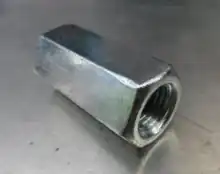Coupling nut
A coupling nut, also known as extension nut, is a threaded fastener for joining two male threads, most commonly a threaded rod,[1][2] but also pipes.[3] The outside of the fastener is usually a hex so a wrench can hold it. Variations include reducing coupling nuts, for joining two different size threads; sight hole coupling nuts, which have a sight hole for observing the amount of engagement; and coupling nuts with left-handed threads.


Coupling nuts can be used to tighten a rod assembly inward or to press a rod assembly outward.[4][5]
Along with bolts or studs, connecting nuts are also often used to make homemade bearing and seal pullers/presses. The advantage of a connecting nut over a standard nut in this application is that, due to its length, a greater number of threads are engaged with the bolt. This helps to spread the force over a larger number of threads, which reduces the possibility of stripping or galling the threads under a heavy load.
References
- "Coupling Nuts". About Nuts, Materials, and Finishes. McMaster-Carr. Retrieved 26 March 2013.
- "Extension Nut / Coupling Nut". KisanEngineers.com. Kisan Engineers Machine Tools. Archived from the original on 27 December 2011. Retrieved 26 March 2013.
- American Railway Master Mechanics' Association (1922). Locomotive Cyclopedia of American Practice (sixth ed.). New York: Simmons-Boardman. p. 32.
- Nunn, Richard V. (1982). Popular Mechanics Guide to Do-It-Yourself Materials. New York: Hearst Books. p. 54. ISBN 978-0-87851-150-1.
- Olin, L.; Stanland, A.; Allard, F. (1987). "Fiber Optic Hull Penetrators for Submarines". In O'Donnell-Leach, Karen (ed.). Military Applications of Fiber Optics. Fiber Optics Reprint Series Volume 14. Brighton, Massachusetts: Information Gatekeepers Inc. pp. 58–63, page 61.